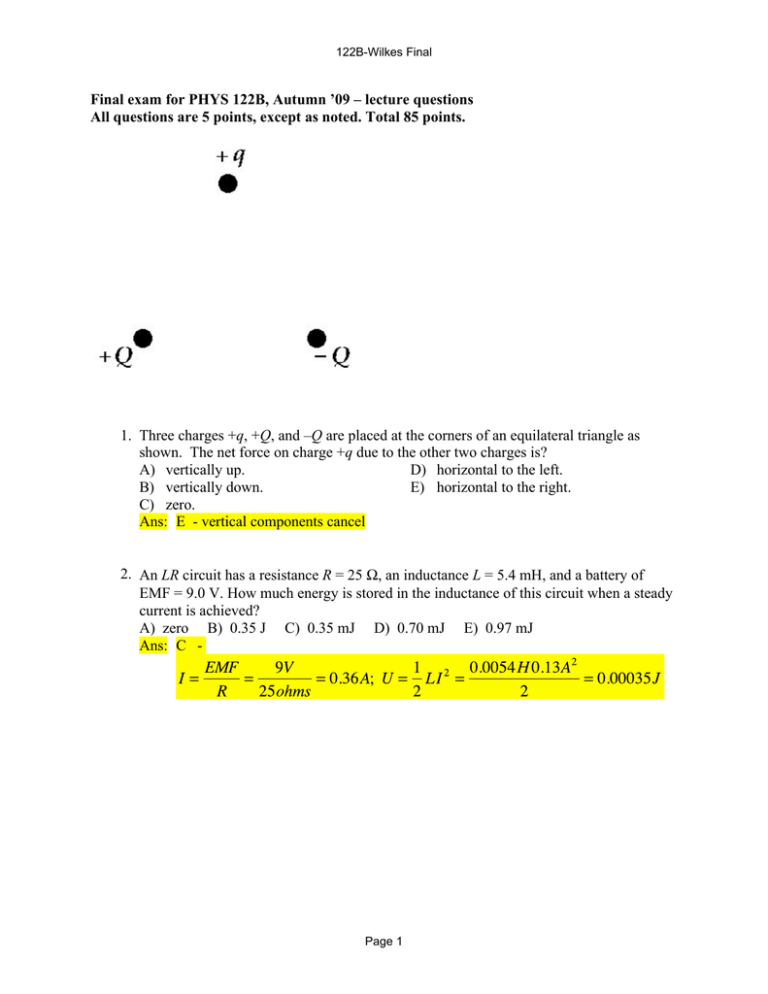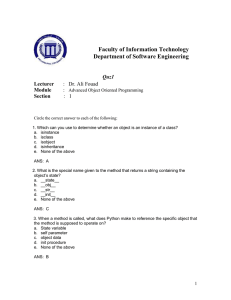Final exam for PHYS 122B, Autumn `09 – lecture questions All
advertisement

122B-Wilkes Final Final exam for PHYS 122B, Autumn ’09 – lecture questions All questions are 5 points, except as noted. Total 85 points. 1. Three charges +q, +Q, and –Q are placed at the corners of an equilateral triangle as shown. The net force on charge +q due to the other two charges is? A) vertically up. D) horizontal to the left. B) vertically down. E) horizontal to the right. C) zero. Ans: E - vertical components cancel 2. An LR circuit has a resistance R = 25 !, an inductance L = 5.4 mH, and a battery of EMF = 9.0 V. How much energy is stored in the inductance of this circuit when a steady current is achieved? A) zero B) 0.35 J C) 0.35 mJ D) 0.70 mJ E) 0.97 mJ Ans: C - Page 1 3. A uniformly positively charged spherical conductor is placed midway between two identical uncharged conducting spheres. How would the charges in the middle sphere be distributed? A) The positive charges stay uniformly distributed on the surface of the middle sphere. B) There are more positive charges near the top and bottom of the sphere compared to the sides next to the two other spheres. C) There are more positive charges near the sides of the spheres that are next to the other two spheres compared to the other regions of the sphere. D) None of these is correct. Ans: C -- induced charges on outside spheres attract original + charge 4. The charge on an originally uncharged, isolated conductor is separated by induction, when a positively charged insulating rod is brought near the conductor (at top of figure above). The rods never touch, and no spark goes between them. For which of the various Gaussian surfaces represented by the dashed lines does ? A) 1 B) 2 Ans: D C) 3 D) 4 E) 5 Page 2 5. The voltage between the cathode and the screen of a television set is 22 kV. If we assume a speed of zero for an electron as it leaves the cathode, what is its speed just before it hits the screen? A) 8.8 ! 107 m/s D) 7.7 ! 1015 m/s B) 2.8 ! 106 m/s E) 5.3 ! 107 m/s 7 C) 6.2 ! 10 m/s Ans: A - 6. The figure depicts a uniform electric field. The direction in which there is no change in the electric potential is A) 1 B) 2 C) 3 D) 4 E) none of these Ans: C - perpendicular to E field Page 3 7. The curve that best represents the time dependence of the current in an RC circuit as the capacitor discharges is A) 1 B) 2 C) 3 D) 4 E) 5 Ans: B - exponential decline of I during discharge: I(t)~ exp(-t/RC) 8. A particle with charge q and mass m is moving with speed v in the +x direction enters a magnetic field of strength B pointing in the +y direction. The work done by the magnetic force on the particle as it travels one semi-circle is A) "mqvB D) zero 2 B) "mv E) "mv/qB C) "qvB Ans: D - Force due to B is always perpendicular to v, does no work. Page 4 9. An electron beam travels counterclockwise in a circle of radius R in the magnetic field produced by Helmholtz coils as shown. The currents in the two coils are equal. If you increase the current in the Helmholtz coils, the electron beam will A) increase its radius. B) decrease its radius. C) maintain the same radius. D) reverse and travel clockwise with the same radius. E) reverse and travel clockwise with a larger radius. Ans: B - B force is proportional to B, so double I in coils = double B = double F. r = v2/a = mv2/F, so double F means r ! r/2 10. How much does the maximum EMF produced by a generator (a rotating coil in a uniform B field) change if the area of the coil is doubled and the angular frequency halved? A) it is the same B) it is increased by a factor of two C) it is increased by a factor of eight D) it is decreased by a factor of four E) it is impossible to tell given the information provided Ans: A – peak EMF is proportional to peak value of d(flux)/dt d (flux)/dt is proportional to coil area and angular frequency 2x area and freq/2 ! same max EMF Page 5 11. At what frequency is the magnitude of the reactance of a 2-mH inductor equal to the magnitude of the reactance of a 100-pF capacitor? A) 2.2 # 106 Hz D) 600 Hz 11 B) 1.3 # 10 Hz E) none of the above 5 C) 3.6 # 10 Hz Ans: C : (notice: responses are given in Hz = unit of linear freq (cycles/s), not angular freq (omega = radians/sec) ) 12. In the circuit shown above, assume that the inductor and the wires have negligible resistance. The switch S was at position a for a long time when it is switched to b. Describe the current flow in the right loop. A) There is no current flow in the loop since it is disconnected from the battery. B) At the instant the switch is at b, the current starts to flow and then decays exponentially. C) The time dependence of the current is a sinusoidal function with frequency . D) The time dependence of the current is a sinusoidal function, with frequency diminishing with time. E) None of the above Ans: C -- see p. 1007 in text. After switch is closed, we have same situation as shown in fig 29-11 in text. Page 6 13. If the existence of magnetic monopoles should ever be confirmed, which of the following equations would have to be altered? A) B) C) D) All the above would have to be altered. E) All the above would still apply without alteration. Ans: B 14. The frequency range for FM broadcasts is from 87.9 – 107.9 MHz in the U.S. In terms of wavelengths, the range corresponds to A) 87.9 – 107.9 m D) 12.4 – 19.5 m B) 2.78 – 3.41 m E) None of these is correct. C) 83.3 – 102.3 m Ans: B -- $ = c/f (written on board) ! (3x108 m/s)/(87.9x106Hz)=3.41m 15. (7 points) The Sun radiates about 3.83 # 1026 W of total power, producing solar radiation of about 1355 W/m2 at the distance of the Earth’s orbit. How large should a perfectly reflecting solar sail be on a space ship of mass 50 kg, to provide an acceleration of 10-4 m/s2 at the Earth’s orbit? (Hint: recall that if radiation is reflected rather than just absorbed, the pressure exerted on the surface is twice the radiation pressure.) The radius of Earth’s orbit is 1.50 # 1011 m, g=9.8 m/s2. A) 550 m2 B) 625 m2 C) 1100 m2 D) 2500 m2 E) None of these is correct. Ans: A -- Pressure P = Fnet / Area, so required force F=ma=5x10-3N, Pressure for reflection =2x rad pressure = 2x(radiation Intensity/c) = 2(Power/unit area)/c = 2(1355 W/m2) / (3x108m/s) = 9x10-6 N/m2, so Area=(5x10-3N) / Pressure = 550m2 Page 7 16. A classroom demonstration is performed by dropping a permanent magnet inside a conducting cylinder, as shown above. The magnet quickly reaches a constant terminal velocity, and can take several seconds to drop a length of about a meter. Suppose the mass of the magnet is 0.07 kg and it has a terminal velocity of 0.01 m/s. The length of the pipe is 0.80 m, and g=9.8m/s2. a) (4 pts) What is the magnitude of the magnetic force on the magnet when it is falling at the terminal velocity? A) 0.35 N D) 0.69 N B) 0.79 N E) None of these is correct. C) 0.97 N Ans: D -- constant v means Fnet=0, so must have upward F on magnet = mg=0.69N b) (4 points) What physical phenomenon does the demonstration illustrate? (Choose one answer you think most appropriate, given the subjects we discussed in 122.) A) Free fall. B) Eddy currents. C) Radiation pressure. D) Electrostatic forces. E) Resistance heating. Ans: B -- not in free fall (v=const), radiation pressure is not relevant, no static charges, no heating involved. Page 8

